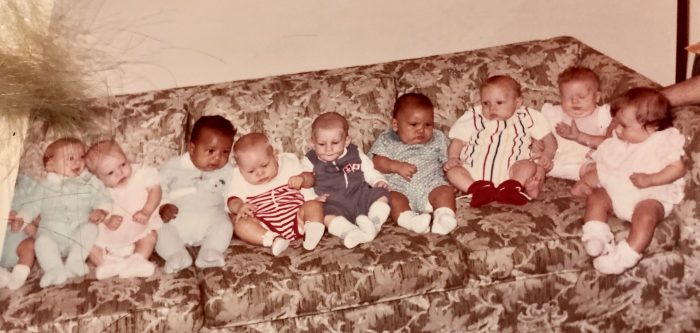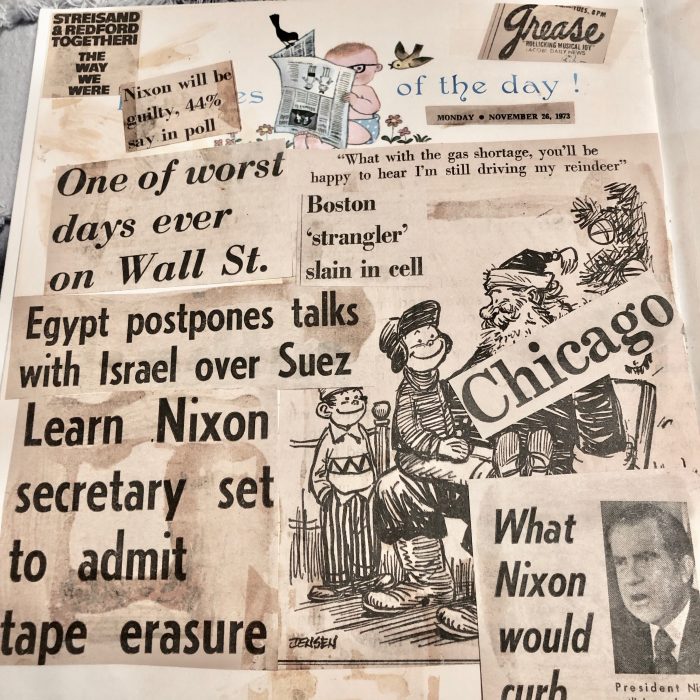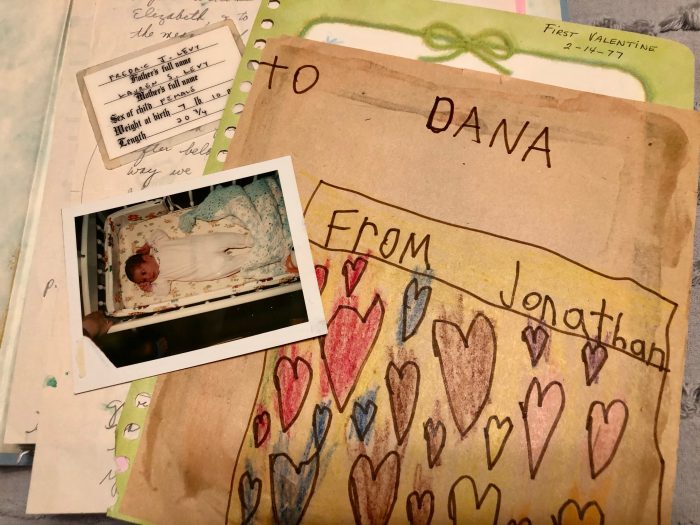
I used to love looking at my baby book as a kid, but after I dug it out of a storage box to write this story, I wondered what was so exciting about it. Perhaps it was that, as the first-born child, I was the only one who had one. Clearly, my mother was not too excited about my development other than my weight, which she dutifully recorded for the first year. My book also contained a tiny baby ring that Mom procured from the Ernst Kern Company as a freebie to “treasure.” Luckily, she never gave it to me to swallow and it remains taped to the page entitled “Important Firsts.”
When I thumb through my mother’s attempt to memorialize my early childhood, it doesn’t really matter what she wrote or what she saved. The love with which she did it is what endures.
According to my mother, I smiled at one month, turned over at eight weeks, got my first tooth at four months, stood alone and sat without help at six months, said Da-Da and Mama at eight months, and walked at 12 months. My toys were a brown doggie, measuring spoons, a black and white panda, a strainer (really?), and a ball. The one page she completely filled in recorded all of the gifts I received at birth. I suspect this was important so she could reciprocate in kind.
When my first child was born, I also made a gift list in his book because I thought that was what was required. But I was determined to be more thorough than my mother and added many baby photos, including this one of the reunion of my Lamaze class featuring a lock of his hair, which obviously came from a later date as he’s the bald guy in denim in the center of the photo:
While I didn’t fill in every question, I dutifully recorded all of his milestones and who attended his first three birthday parties. After that, all I had time to did was shove in his elementary school group class photos because he had a baby sister and her book called out to me. One thing I did of which I’m still pretty proud was to glue the headlines of the day onto a random page in each of my kids’ books. Here are the things that happened on November 26, 1973, when my first daughter was born:
By the time I got to a baby book for my third child, I had a much shorter list of gifts (maybe folks were not as into my having kids by then). But that list is proof that my friend’s mother gave her Henry, her much-loved pink teddy bear that she passed on to one of her kids. Other than that, and a few entries on the height/weight page, her book is a mess. This is largely due to the fact that she, like me, was obsessed with it as a child. Unlike my mother, I let her play with it all of the time. As a result, an envelope with a lock of her hair which she examined constantly disappeared. Here’s what her book looks like today:
In recent years, I have come to wonder about how these books feel to parents whose children’s milestones fall outside of common developmental expectations. Questions about when a child first rolled over, sat up, crawled, stood alone, walked, talked, or hit other first-year expectations are painful for parents whose children did not do these things at the typical time, or may not do them at all. How do parents whose children join their family though adoption fill in sections asking to describe their mother’s pregnancy or birth experiences? Family tree pages can also present challenges to adoptees or children from non-traditional family structures. The kind of baby books I bought and completed for my children assumed there was a mommy and a daddy, not always the case these days. For many of these reasons, my children and their friends would not feel comfortable completing the traditional commercial baby book for their children.
I didn’t think about these issues when my children first became parents and I copied the pages from their baby books for them. I have no idea if they kept those copies, so I’m glad I held on to the originals. Like the other mementos of their childhood – drawings, skating ribbons, sports trophies, award certificates – that reside in my basement, I now realize that these things mean more to me than to them.
Nevertheless, I suspect that someday my kids will take the baby books I made for them out of an obscure storage place like I did mine. I hope they will feel the way I do when I thumb through my mother’s attempt to memorialize my early childhood. It doesn’t really matter what she wrote or what she saved. The love with which she did it is what endures.
I invite you to read my book Terribly Strange and Wonderfully Real and join my Facebook community.
Boomer. Educator. Advocate. Eclectic topics: grandkids, special needs, values, aging, loss, & whatever. Author: Terribly Strange and Wonderfully Real.






Wonderful Laurie, and as ever your love for your family and your kids shines right through! And your comments about today’s non-traditional families and how a baby book might cause more pain than pleasure gave pause for thought.
Brava Laurie.
Thanks, Dana. I think my fascination with my own baby book was that my mother recorded these things so I could know a bit about my babyhood.
Interesting that you had a baby book, Laurie. Like your mother, I filled in all the gifts, so that I could send thank you notes (there are check marks when I sent them out).
You raise very interesting questions about the new and changing definition of family, as well as the “normal” range for meeting milestones. Plus, how many of today’s youth actually write and fill out paper forms? I suspect baby books may be a bygone product now.
Sadly, Betsy, I think you are right about baby books becoming a relic for a generation that avoids paper and keeps photos on their phones. Maybe that’s good for the reasons I raised but I also feel sad that my grandkids probably don’t have records of their early childhood.
Laurie, your baby books are amazing! No wonder you suggested this prompt! I love that you put in headlines from the day they were born. I kept the entire newspaper from the day each child was born, but that’s pretty unwieldy, and I have no idea where they are now. Cutting out headlines would have been so much better!
On your comment about milestones not reached, it was interesting to see which stickers I *didn’t* use in my baby calendars. I was reminded that my youngest never crawled when I saw the unused “crawled” sticker on the back page. Worrisome at the time, but she turned out okay. If there were too many stickers that didn’t apply, it would be pretty upsetting, I imagine.
As always, great story, with lots to think about.
Suzy, as you can tell from the sample I posted, after I cut out those headlines I glued them with rubber cement to a random page (probably “Baby’s First Christmas”). They have yellowed and the glue shows through, so probably not the best method. I think those stickers of expected milestones would have been alarming if you couldn’t have used all of them for your first child. When I think of my twin granddaughters who never had too many of those cute first words, it pains me now to imagine my daughter filling out their baby books. I don’t know if she ever finished them. Another woman I know whose son has cerebral palsy and didn’t walk until he was 2-1/2 shared how painful it was to track his development. Apparently. Barbara found one baby book that has open-ended prompts for milestones and inclusive language. I asked her to share the link because I think it would be helpful to so many families who still want to keep the kinds of records we did for our kids.
Laurie, your loving story made me think there’s a need for a new type of baby book that is adaptable to non-traditional norms, not only in terms of developmental milestones but same sex couples, single parents, adoptions, etc. I turned to Google and there IS one — just one — that has open-ended prompts for milestones and replaces traditional verbiage to make it LGBTQ friendly, although it doesn’t address the single parent.
I for one hope paper baby books, like parental love, never go out of style!
Barbara, I agree that the loss of written paper records and printed photos is huge. I hope these things will make a come back as not everything can be saved on a phone. Could you ut up a link to the book you found? I may want to gift it to the next person I know who has a baby.
Hi Laurie, here’s the link . . . I’m not sure how to make it a live link here but you can copy and paste. There might be more out there (and I’d think there will certainly be more to come), but this one caught my attention: https://www.amazon.com/Minimalist-Keepsake-Milestone-Journal-Friendly/dp/B07DN6X51K/ref=asc_df_B07DN6X51K/?tag=hyprod-20&linkCode=df0&hvadid=241903337278&hvpos=1o4&hvnetw=g&hvrand=13656192050851776521&hvpone=&hvptwo=&hvqmt=&hvdev=c&hvdvcmdl=&hvlocint=&hvlocphy=9031589&hvtargid=pla-523798560628&psc=1
That is a very nice book. Thanks for researching that.
Laurie, I echo the sentiments others have left here regarding the way the baby books of the past do not address the current needs of parents or children. While I duly recorded the many traditional “firsts” in my kids’ books, I can see the many ways in which those books fell short. It’s good to know that at least one alternative is out there. And judging from the way my grandchildren love looking through picture books and albums, I think we’re a long way from giving up the notion of “hard copies”! Excellent post.
Thanks, Risa. Now I will read your story. My grandkids also love looking at my photo books and framed pictures, especially of them. They are also curious about their parents’ childhoods, so I’m glad I documented what I could.
What a lovely story, Laurie, and the pictures complement it beautifully. And, as with others, I was struck by your sensitivity and empathy in wondering — in retrospect — about families with children with developmental issues.
And your excerpt was perfect. It really said it all.
Thanks, John. I should have included a photo of my bronzed baby shoes, which I inherited after my mother died. I wonder if my younger brothers were jealous. Probably not, as now I am stuck with them and I know they mesnt much more to her than to me.